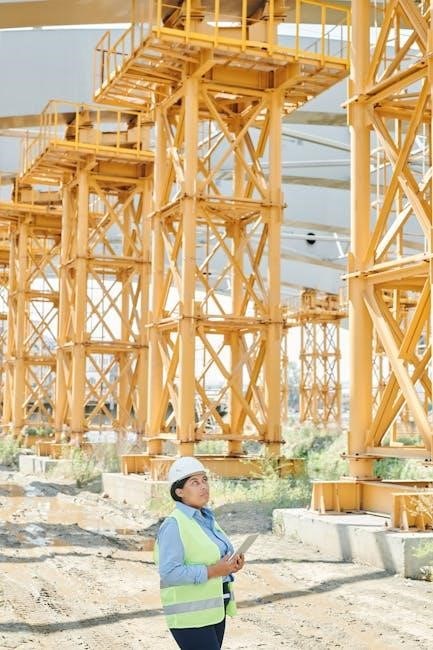A Construction Site Safety Plan ensures a safe working environment by outlining hazard controls, compliance measures, and emergency procedures. It addresses site-specific risks and adheres to local regulations, providing a framework for incident prevention and response. Free PDF templates are widely available online to help customize safety plans for specific projects.
1.1 Overview of Construction Site Safety
Construction site safety encompasses protocols, regulations, and practices to minimize risks and ensure a safe working environment. It involves hazard identification, compliance with local legislation, and implementation of control measures. Key elements include personal protective equipment, emergency preparedness, and regular training. Adherence to safety standards protects workers, reduces incidents, and promotes efficiency. Free PDF templates are available online, providing customizable frameworks for developing comprehensive safety plans tailored to specific project needs.
1.2 Importance of Having a Safety Plan
A safety plan is crucial for preventing accidents, ensuring compliance with regulations, and fostering a culture of safety. It protects workers, reduces liability, and enhances project efficiency; By addressing site-specific risks, a well-prepared plan ensures preparedness for emergencies and minimizes environmental impact. Utilizing free PDF templates simplifies the creation of tailored safety plans, promoting a safer and more organized construction site environment for all stakeholders involved.

Construction Site Safety Manual
A Construction Site Safety Manual is a comprehensive guide ensuring safety and regulatory compliance. It includes policies, procedures, and templates to manage risks effectively on-site. Free PDF versions are available for easy access and customization, providing a structured approach to maintaining a safe working environment.
2.1 Table of Contents for Safety Manuals
- Safety Responsibilities
- Hazard Identification
- Personal Protective Equipment (PPE)
- Emergency Procedures
- Compliance with Regulations
- Management Roles
- Training Programs
- Incident Reporting
- Environmental Considerations
2.2 List of Appendices and Revision Tables
Appendices in safety manuals typically include forms, checklists, and supplementary documents like emergency contact lists and PPE guidelines. Revision tables track updates, ensuring the manual stays current with regulations. Free PDF templates often include these sections, allowing users to customize appendices and revision logs to suit their project needs while maintaining compliance and clarity.
- Emergency contact list
- Incident report forms
- PPE guidelines
- Revision history table
Site-Specific Safety Plan (SSSP)
A Site-Specific Safety Plan is a tailored document addressing unique risks and controls for a particular site, ensuring compliance with safety protocols and regulations.
3.1 What is a Site-Specific Safety Plan?
A Site-Specific Safety Plan (SSSP) is a customized safety document outlining how management intends to control exposure to risks at a specific site. It ensures compliance with safety protocols and regulations by addressing unique conditions and potential hazards. Free PDF templates can be used to create a detailed SSSP, providing a structured approach to site safety management and hazard mitigation.
3.2 How to Prepare a Site-Specific Safety Plan
Preparing a Site-Specific Safety Plan involves identifying site risks, outlining safety procedures, and detailing emergency protocols. Start with a hazard assessment to address unique site conditions. Include compliance measures, safety responsibilities, and control strategies. Utilize free PDF templates for structure and customization. Regularly review and update the plan to ensure relevance and effectiveness in mitigating risks and protecting workers throughout the project lifecycle.
Personal Protective Equipment (PPE)
Ensure proper PPE, including safety glasses, fall protection, and respiratory equipment, is worn at all times. Employers must provide additional eye and face protection as needed.
4.1 Eye Protection Requirements
Safety glasses must be worn at all times in construction areas. Employers are responsible for providing additional eye and face protection based on specific job risks. Compliance with industry standards ensures effective protection, preventing injuries from debris, chemicals, or optical hazards. Regular inspections of PPE are essential to maintain safety and adherence to regulations, as outlined in free construction site safety plans.
4.2 Fall Protection and Respiratory Equipment
Fall protection equipment, such as harnesses and guardrails, is essential for preventing falls from heights. Respiratory equipment, including masks and respirators, is critical in environments with airborne hazards. Proper fitting, maintenance, and regular inspections of these devices ensure effectiveness. Employers must provide training on their use, as outlined in free construction site safety plans, to safeguard workers from falls and respiratory risks.

Emergency Preparedness and Response
Emergency preparedness involves establishing clear procedures for incidents, communication, and evacuation. Free construction site safety plan PDFs often include templates for emergency response protocols to ensure quick action.
5.1 Emergency Procedures for Construction Sites
Emergency procedures for construction sites include evacuation plans, fire safety protocols, and first aid response. Free PDF safety plans often outline step-by-step actions for incidents, ensuring quick reaction. They typically detail evacuation routes, assembly points, and communication protocols. Compliance with fire codes and regular drills are emphasized to prepare workers for potential hazards, ensuring a coordinated and effective response during emergencies.
5.2 Evacuation Plans and Fire Safety
Evacuation plans and fire safety are critical components of construction site safety. Free PDF safety templates often include detailed evacuation routes, emergency exits, and fire extinguisher locations. These plans ensure compliance with fire codes and provide clear procedures for emergencies. Regular drills are recommended to prepare workers for rapid evacuation. Effective evacuation plans minimize risks and ensure a timely response during fires or other emergencies, adhering to safety regulations.

Compliance with Safety Regulations
Compliance with safety regulations ensures adherence to local laws and industry standards, minimizing risks and legal liabilities. Fire safety codes and regular audits guarantee proper implementation of safety measures.
6.1 Local Legislation and Industry Standards
Compliance with local legislation and industry standards is critical for ensuring safety on construction sites. These regulations provide guidelines for hazard control, PPE usage, and emergency preparedness. Free PDF templates often include sections that help align safety plans with these standards, ensuring legal adherence and reducing risks. Adhering to these frameworks promotes a safer working environment and prevents violations.
6.2 Role of Fire Safety Codes and Officers
Fire safety codes and officers play a crucial role in enforcing safety standards on construction sites. These codes outline specific requirements for fire prevention, detection, and suppression systems. Officers conduct inspections to ensure compliance, addressing potential fire hazards and ensuring safe working conditions. Their involvement is essential for maintaining a secure environment, as outlined in many free PDF safety plan templates available online.
Management’s Role and Responsibilities
Management is responsible for ensuring all employees are properly trained and comply with safety protocols. They oversee safety measures, fostering a culture of accountability and adherence to regulations.
7.1 Ensuring Employee Training and Compliance
Management must ensure all employees receive mandatory training tailored to their roles, ensuring compliance with safety standards. Regular updates and refreshers are crucial to maintain awareness and adherence to protocols, fostering a safe work environment. Utilizing free PDF templates can help structure these training programs effectively, ensuring comprehensive coverage of safety practices and regulatory requirements.
7.2 Oversight of Safety Protocols
Oversight of safety protocols is a critical function led by management and supervisors to ensure compliance and adherence to established safety measures. Regular inspections and audits are conducted to identify and rectify potential hazards, ensuring all activities align with local legislation and industry standards. This oversight minimizes risks and ensures a safe working environment, supported by comprehensive safety plans and free PDF templates available for customization.
Hazard Identification and Risk Assessment
Hazard identification involves recognizing potential risks on-site, such as equipment malfunctions or environmental hazards. Risk assessment evaluates these hazards to determine severity and implement control measures effectively.
8.1 Identifying Potential Hazards on Site
Identifying potential hazards on construction sites involves recognizing risks like falling objects, equipment malfunctions, and environmental factors. Regular inspections and checklists from free PDF safety plans help pinpoint these dangers, ensuring a proactive approach to safety. Workers and managers should remain vigilant to spot hazards early, preventing accidents and maintaining a safe work environment at all times.
8.2 Implementing Risk Control Measures
After identifying hazards, implementing risk control measures is crucial. Free PDF safety plans often outline strategies like engineering controls, PPE, and administrative procedures. Regular training and drills ensure compliance, while continuous monitoring adapts controls to changing site conditions. Effective implementation minimizes risks, ensuring a safer workplace and preventing incidents.

Environmental Considerations
Construction safety plans address environmental concerns, such as minimizing waste and managing subsurface contaminants. Free PDF templates offer guidelines to reduce environmental impact while ensuring compliance with regulations.
9.1 Addressing Subsurface Contaminants
Construction safety plans often include measures to address subsurface contaminants, ensuring activities minimize environmental impact. Free PDF templates provide guidelines for handling contaminated soil and groundwater, emphasizing compliance with local regulations. These plans outline procedures for safe excavation, disposal, and monitoring to prevent contamination spread, ensuring a safe working environment and protecting ecological health.
9.2 Minimizing Waste and Environmental Impact
Construction safety plans emphasize minimizing waste and environmental impact through sustainable practices. Free PDF templates often include strategies for recycling materials, reducing waste generation, and ensuring proper disposal. These plans also address measures to prevent pollution, such as controlling spills and managing emissions. By incorporating eco-friendly practices, construction sites can reduce their environmental footprint while maintaining compliance with local and environmental regulations.

Training and Awareness Programs
Training ensures employees understand safety protocols, hazard identification, and emergency procedures. Regular updates and drills reinforce a culture of safety, reducing incident risks and enhancing compliance.
10.1 Mandatory Training for Construction Workers
Mandatory training equips workers with essential safety knowledge, ensuring compliance with regulations. Topics include hazard identification, PPE usage, and emergency response. Regular updates keep skills current, preventing accidents and fostering a safer workplace environment. Employers must verify completion and maintain records to ensure all employees are adequately trained for their specific roles and tasks on site.
10.2 Regular Safety Drills and Updates
Regular safety drills ensure preparedness for emergencies, reinforcing protocols like evacuation procedures and fire response. Updates address new risks and regulatory changes, keeping safety measures current. These practices maintain a proactive approach to workplace safety, reducing incidents and ensuring compliance with evolving standards and legislation.

Monitoring and Enforcement
Regular safety inspections ensure compliance with protocols and standards. Enforcement involves addressing non-compliance promptly to maintain a safe work environment and prevent potential hazards.
11.1 Conducting Regular Safety Inspections
Regular safety inspections are essential to identify and correct potential hazards. They involve systematic evaluations of compliance with safety protocols, equipment condition, and workplace practices. Inspectors use checklists to ensure thoroughness. Findings are documented and addressed promptly. Free PDF templates for safety plans often include inspection forms and procedures to streamline the process. This proactive approach helps maintain a safe and compliant work environment.
11.2 Corrective Actions for Non-Compliance
Corrective actions address non-compliance by identifying root causes and implementing solutions. Steps include documenting violations, assigning responsibility, and setting timelines for resolution. Free safety plan templates often include forms for tracking corrective measures. Follow-ups ensure compliance and prevent recurrence. Proper documentation and communication are vital to maintaining accountability and workplace safety standards.
Incident Reporting and Investigation
Incident reporting involves documenting and analyzing events to prevent recurrence. Free PDF templates provide structured formats for thorough investigations and compliance with safety standards.
12.1 Procedures for Reporting Incidents
Incident reporting requires immediate notification of accidents or near-misses. Free PDF safety plans include forms for documenting details like dates, locations, and witness statements. Supervisors must review and submit reports to compliance officers. Follow-up actions, such as corrective measures and investigations, are documented to ensure accountability and prevent future incidents. Proper reporting ensures transparency and compliance with safety regulations, promoting a safer work environment.
12.2 Analyzing Causes and Preventing Recurrence
Analyze incident causes using root cause analysis tools like the “5 Whys” to identify underlying factors. Document findings and implement corrective actions, such as training or equipment adjustments. Preventive measures should be communicated to all team members to avoid recurrence. Regular reviews of safety protocols ensure sustained improvement. Free PDF safety plans often include templates for root cause analysis and preventive action tracking to enhance workplace safety.
Availability of Free Safety Plan Templates
Free construction site safety plan PDF templates are widely available online, offering customizable formats to suit specific project needs. Downloadable from trusted sources, they simplify safety planning.
13.1 Sources for Free PDF Templates
13.2 Tips for Customizing Templates
Customize templates by adding company logos, site-specific details, and project requirements. Ensure compliance with local regulations and include hazard assessments. Tailor emergency procedures and evacuation plans to the site. Regularly update the plan to reflect changes in work scope or risks. Use clear language and ensure all stakeholders review and approve the finalized document before implementation.
A well-structured Construction Site Safety Plan is essential for ensuring safety and compliance. Utilizing free PDF templates can streamline customization, enhancing site-specific safety measures and fostering a safer work environment.
14.1 Final Thoughts on Construction Site Safety
Construction site safety is paramount to protecting workers and ensuring project success. A well-crafted safety plan, supported by free PDF templates, aids in compliance and customization. Regular training, hazard identification, and emergency preparedness are critical. By adhering to local legislation and industry standards, sites can minimize risks and foster a culture of safety. Utilizing available resources ensures a safer, more efficient work environment for all.